A Concept for a Consolidated Humus Form Description—An Updated Version of German Humus Form Systematics
Abstract
1. Introduction
2. German Humus Form Systematics
2.1. Structure of the Hierarchical Humus Form Systematics
2.2. Description of Humus Forms
2.2.1. Division: Aeromorphic and Aero-Hydromorphic Humus Forms
- Class: Mull humus forms
- Oh horizon is never present.
- Ol horizon is present, but is incoherent to sparse;
- Olf horizon is absent, patchy, or thin; and
- Ax, Au, or Ah horizon with signs of high biological activity is present.
- Subtypes
- Ol horizon is only temporarily present (autumn to early summer), and
- Olf horizon is absent or only present for a short time (Figure 5b).
- Ol horizon is present almost all year round, and
- Olf horizon is patchy, sparse, and only temporarily present.
- Ol horizon is present, which is mostly patchy or sparse and patchy.
- Olf horizon is temporarily present.
- Adx horizon, Adu horizon, or Adh horizon is observed with signs of high biological activity.
- Owl horizon is present almost all year round;
- Owlf horizon is present but is patchy and sometimes black smeary leaves are visible and
- hydromorphic features in the A horizon.
- Ol horizon is present;
- Of horizon is continuous and present all year round; and
- Ax, Au, or Ah horizon is present.
- Subtypes
- Ol horizon is present all year round;
- Olf is continuous and present all year round;
- Ohf horizon is absent; and
- Ax, Au, or Ah horizon is present.
- Ol horizon is present all year round;
- Olf horizon and Ohf horizon are continuous and present all year round;
- the thickness of Olf ≥ Ohf horizon and
- Ax, Au, or Ah horizon is present.
- Ol horizon and Of horizon is present all year round; and
- Adx, Adu, or Adh is present.
- Ol horizon and Olf horizon are present;
- Ohf is present, thickness of Ohf >> than Olf horizon; and
- Au or Ah horizon present.
- Owl horizon is present almost all year round;
- Owf horizon is present; and
- hydromorphic features in the A horizon.
- Class: Humus forms with an Oh horizon
- Ol horizon and Of horizon are present all year round;
- Obh horizon is present, which is in parts very thin or patchy; and
- a thin Ah horizon or Ee horizon has developed.
- Subtypes
- Ol and Olf horizon are present all year round;
- Ohf horizon is present all year round, usually rooted;
- Oih horizon is present; and
- Ah horizon is present.
- Ol horizon and Olf horizon are present all year round;
- Ohf horizon is present all year round, usually rooted;
- Obh horizon is present;
- indistinct transitions between O horizons; and
- occurrence of a thin Ah horizon or Ee-Ah horizon or Ah-Ee horizon.
- Ol horizon is present all year round and
- Odf horizon above Odh horizon is present all year round or features of both horizons (Odf + Odh) exist parallel all year round and
- a thin Ah horizon or Ee-Ah horizon or Ah-Ee horizon occurs.
- Ol horizon is present all year round;
- Of horizon is present all year round and thin (<5 cm);
- Obh horizon is present, with diffuse boundary with underlying Ovh; and
- Ovh horizon is present and directly overlies the C horizon.
- Ol and Of horizons are present all year round; and
- Oxh horizon is present that either directly overlies the bedrock, or fills the voids in the rubble or, more rarely, overlies mineral soil.
- Ol horizon or Owl horizon is present;
- Of horizon or Owf horizon is present;
- Owbh horizon is present; and
- overlying a hydromorphic topsoil horizon (A horizon with redoximorphic features).
- Ol and Of horizons are present;
- Osh horizon or Okh horizon is present; and
- an acidic bleached horizon (Ee-Ah horizon, Ah-Ee horizon or Ee horizon) is present.
- Subtypes
- Ol horizon, Of horizon and Okh horizon are present; and
- an Ah-Ee horizon or Ee horizon has developed.
- Ol horizon is present all year round;
- Of horizon is present all year round, strongly felted, and flexural;
- Osh horizon is present, sharp-edged, and crushable; and
- Ah-Ee horizon or Ee horizon is present.
- Ol horizon or Owl horizon and Of horizon or Owf horizon are present and
- Owsh horizon is present; and
- overlying a hydromorphic topsoil horizon (A horizon with redoximorphic features).
- Class: Initial Humus Forms
- Ol horizon is present;
- if an Of horizon is present, it is of minor thickness or is incomplete;
- a horizon is of minor thickness and less structured or an A horizon is absent; and
- distinct features of earthworm activity, e.g., earthworm channels, middens and casts are rarely observed.
- Ol horizon is present;
- Of horizon is frequently present, but of minor thickness and incomplete; and
- Oh horizon is absent.
- Class: Naturally and Anthropogenically degraded humus forms
- extensive uncovered surface of the mineral soil despite existing vegetation or
- sporadically occurring soil crust on the surface of the mineral soil consisting of algae, lichens, or a thin cover with mosses.
- Ol horizon und Of horizon are present, with strongly varying thickness;
- Of horizon is characterised by little organic fine material, which is layer-like felted and flexural;
- Oh horizon is missing or only is 0.5 to 1 cm thick in medium aged and old pine or spruce forests;
- Ah-Ee horizon (often semi- to entirely podzolised soils) has a low-to-medium organic matter content, has a coherent to single grain structure in most cases, and is relatively thin (frequently < 3 cm);
- abrupt transition boundaries between Of horizon and Oh horizon, Oh horizon, and Ah-Ee horizon; and
- Of has a CN-ratio of mostly >32, the N content is always <1.7% weight, and the pH-KCl mostly <pH 3.
2.2.2. Division: Hydromorphic Humus Forms
3. Discussion
4. Conclusions
Supplementary Materials
Author Contributions
Funding
Institutional Review Board Statement
Informed Consent Statement
Data Availability Statement
Acknowledgments
Conflicts of Interest
References
- Green, R.N.; Trowbridge, R.L.; Klinka, K. Towards a Taxonomic Classification of Humus Forms. For. Sci. 1993, 39, 1–49. [Google Scholar] [CrossRef]
- von Zezschwitz, E. Ansprachemerkmale der Terrestrischen Waldhumusformen des Nordwestdeutschen Mittelgebirgsraumes; Geologisches Jahrbuch; Reihe F3; Federal Institute for Geosciences and Natural Resources: Hannover, Germany, 1976; pp. 53–105. [Google Scholar]
- Albrecht, C.; Jahn, R.; Huwe, B. Bodensystematik und Bodenklassifikation Teil I: Grundbegriffe. J. Plant Nutr. Soil Sci. 2005, 168, 7–20. [Google Scholar] [CrossRef]
- Albrecht, C.; Jahn, R.; Huwe, B. Bodensystematik und Bodenklassifikation Teil II: Zur Situation in der deutschen Bodenkunde. J. Plant Nutr. Soil Sci. 2005, 168, 157–168. [Google Scholar] [CrossRef]
- Kubiëna, W.L. Die Bedeutung des Begriffes “Humusform” für die Bodenkunde und Humusforschung. Z. Pflanzenernähr. Bodenkde 1955, 69, 3–7. [Google Scholar] [CrossRef]
- IUSS Working Group WRB. World Reference Base for Soil Resources. International Soil Classification System for Naming Soils and Creating Legends for Soil Maps, 4th ed.; International Union of Soil Sciences (IUSS): Vienna, Austria, 2022; pp. 1–400. [Google Scholar]
- Broll, G.; Brauckmann, H.-J.; Overesch, M.; Junge, B.; Erber, C.; Milbert, G.; Baize, D.; Nachtergaele, F. Topsoil characterization-recommendations for revision and expansion of the FAO-Draft (1998) with emphasis on humus forms and biological features. J. Plant Nutr. Soil Sci. 2006, 169, 453–461. [Google Scholar] [CrossRef]
- Jabiol, B.; Zanella, A.; Ponge, J.-F.; Sartori, G.; Englisch, M.; van Delft, B.; de Waal, R.; Le Bayon, R.C. A proposal for including humus forms in the World Reference Base for Soil Resources (WRB-FAO). Geoderma 2013, 192, 286–294. [Google Scholar] [CrossRef]
- Ditzler, C.A.; Hempel, J. Soil Taxonomy and Soil Classification. In International Encyclopedia of Geography: People, the Earth, Environment and Technology; Richardson, D., Castree, N., Goodchild, M.F., Kobayashi, A., Liu, W., Marston, R.A., Eds.; John Wiley & Sons, Ltd.: Hoboken, NJ, USA, 2017; pp. 1–15. [Google Scholar] [CrossRef]
- Fiedler, S.; Jungkunst, H.P.; Jahn, R.; Kleber, M.; Sommer, M.; Stahr, K. Linking soil classification and soil dynamics—Pedological and ecological perspectives. J. Plant Nutr. Soil Sci. 2002, 165, 517–529. [Google Scholar] [CrossRef]
- Hellwig, N.; Graefe, U.; Tatti, D.; Sartori, G.; Anschlag, K.; Beylich, A.; Gobat, J.-M.; Broll, G. Upscaling the spatial distribution of enchytraeids and humus forms in a high mountain environment on the basis of GIS and fuzzy logic. Eur. J. Soil Biol. 2017, 79, 1–13. [Google Scholar] [CrossRef]
- AG Boden. Bodenkundliche Kartieranleitung, 6th ed.; (in press). Federal Institute for Geosciences and Natural Resources: Hannover, Germany, 2023.
- Post, L. von Sveriges Geologiska Undersöknings torvinventering och några av dess hittills vunna resultat. Sven. Mosskulturföreningens Tidskr. 1922, 37, 1–27. [Google Scholar]
- Roeschmann, G.; Grosse-Braukmann, G.; Kuntze, H.; Blankenburg, J.; Tüxen, J. Vorschläge zur Erweiterung der Bodensystematik der Moore. Geol. Jahrb. 1983, 29, 1–49. [Google Scholar]
- Müller, P.E. Studien Über Die Natürlichen Humusformen Und Deren Entwicklung Auf Vegetation und Boden; Verlag Julius Springer: Berlin, Germany, 1887; 324p. [Google Scholar]
- Hesselmann, H. Studier över barrskogens humustäcke, dess egenskaper och beroende av skoksvården. Meddelanden från Statens Skogsförzöksanstalt, Häfte 22; Statens Skogsförsöksanstalt: Stockholm, Sweden, 1926; p. 384. [Google Scholar]
- Wittich, W. Der heutige Stand unseres Wissens vom Humus und neue Wege zur Lösung des Rohhumusproblems im Walde. In Schriftenreihe der Forstlichen Fakultät der Universität Göttingen; J.D. Sauerländer’s Verlag: Bad Orb, Germany, 1952. [Google Scholar]
- Ewald, E. Die Einteilung der Waldhumusformen. In Forstliche Standortsaufnahme, 1st ed.; Landwirtschaftsverlag Münster-Hiltrup: Münster, Germany, 1958; pp. 23–30. [Google Scholar]
- Baritz, R. Humus Forms in Forests of the Northern GERMAN Lowlands. Ph.D. Dissertation, Institute of Ecology, Technical University Berlin, Berlin, Germany, 2001; p. 147. [Google Scholar]
- Babel, U.; Kreutzer, K.; Ulrich, B.; Von Zezschwitz, E.; Zöttl, H.W. Definitionen zur Humusmorphologie der Waldböden. Z. Pflanzenernähr. Bodenkde. 1980, 143, 564–568. [Google Scholar] [CrossRef]
- Working Group on Humus Forms, German Soil Science Society. Available online: https://humusformen.de (accessed on 18 July 2023).
- van Delft, B.; de Waal, R.; Kemmers, R.; Mekkink, P.; Sevink, J. Humus Forms: Description and Classification of Humus forms for Ecological Applications; Ministry of Agriculture, Nature and Food Quality (LNV): Wageningen, The Netherlands, 2006. [Google Scholar]
- Graefe, U. Humusformengliederung aus bodenzoologischer Sicht. Mitteilungen Der Dtsch. Bodenkd. Ges. 1994, 74, 41–44. [Google Scholar]
- Zanella, A.; Ponge, J.-F.; de Waal, R.; Ferronato, C.; De Nobili, M.; Juilleret, J. Humusica 1, article 3: Essential bases–Quick look at the classification. Appl. Soil Ecol. 2018, 122, 42–55. [Google Scholar] [CrossRef]
- Bodenkundliche Gesellschaft der Schweiz, Arbeitsgruppe Bodenklassifikation und Nomenklatur. BGS Klassifikation der Böden der Schweiz, 3rd ed.; Bodenkundliche Gesellschaft der Schweiz, Arbeitsgruppe Bodenklassifikation und Nomenklatur: Zurich, Switzerland, 2010; p. 86. [Google Scholar]
- Nestroy, O.; Aust, G.; Blum, W.E.H.; Englisch, M.; Hager, H.; Herzberger, E.; Kilian, W.; Nelhiebel, P.; Ortner, G.; Pecina, E.; et al. Systematische Gliederung der Böden Österreichs-Österreichische Bodensystematik 2000 in der revidierten Fassung von 2011. Mitteilungen Österr. Bodenkd. Ges. 2012, 79, 1–96. [Google Scholar]
- Kõlli, R.; Tamm, I. Humus cover and its fabric depending on pedo-ecological conditions and land use: An Estonian approach to classification of humus forms. Est. J. Ecol. 2013, 62, 6. [Google Scholar] [CrossRef]
- Ad-hoc-Arbeitsgruppe Boden. Bodenkundliche Kartieranleitung, 5th ed.; Federal Institute for Geosciences and Natural Resources: Hannover, Germany, 2005; p. 438. [Google Scholar]
- Schoeneberger, P.J.; Wysocki, D.A.; Benham, E.C. Soil Survey Staff. Field Book for Describing and Sampling Soils, 3rd ed.; Natural Resources Conservation Service, National Soil Survey Center: Lincoln, NE, USA, 2012. [Google Scholar]
- Wittich, W. Der Einfluss der Baumart auf den allgemeinen Bodenzustand. AFZ 1961, 16, 41–45. [Google Scholar]
- Standortskartierung, A. Forstliche Standortsaufnahme, 7th ed.; IHW-Verlag: München, Germany, 2016; p. 400. [Google Scholar]
- ICP Forests MANUAL on Methods and Criteria for Harmonized Sampling, Assessment, Monitoring and Analysis of the Effects of Air Pollution on Forests-Part IIIa: Sampling and Analysis of Soil. Update April 2006. Available online: http://icp-forests.net/page/icp-forests-manual (accessed on 25 May 2023).
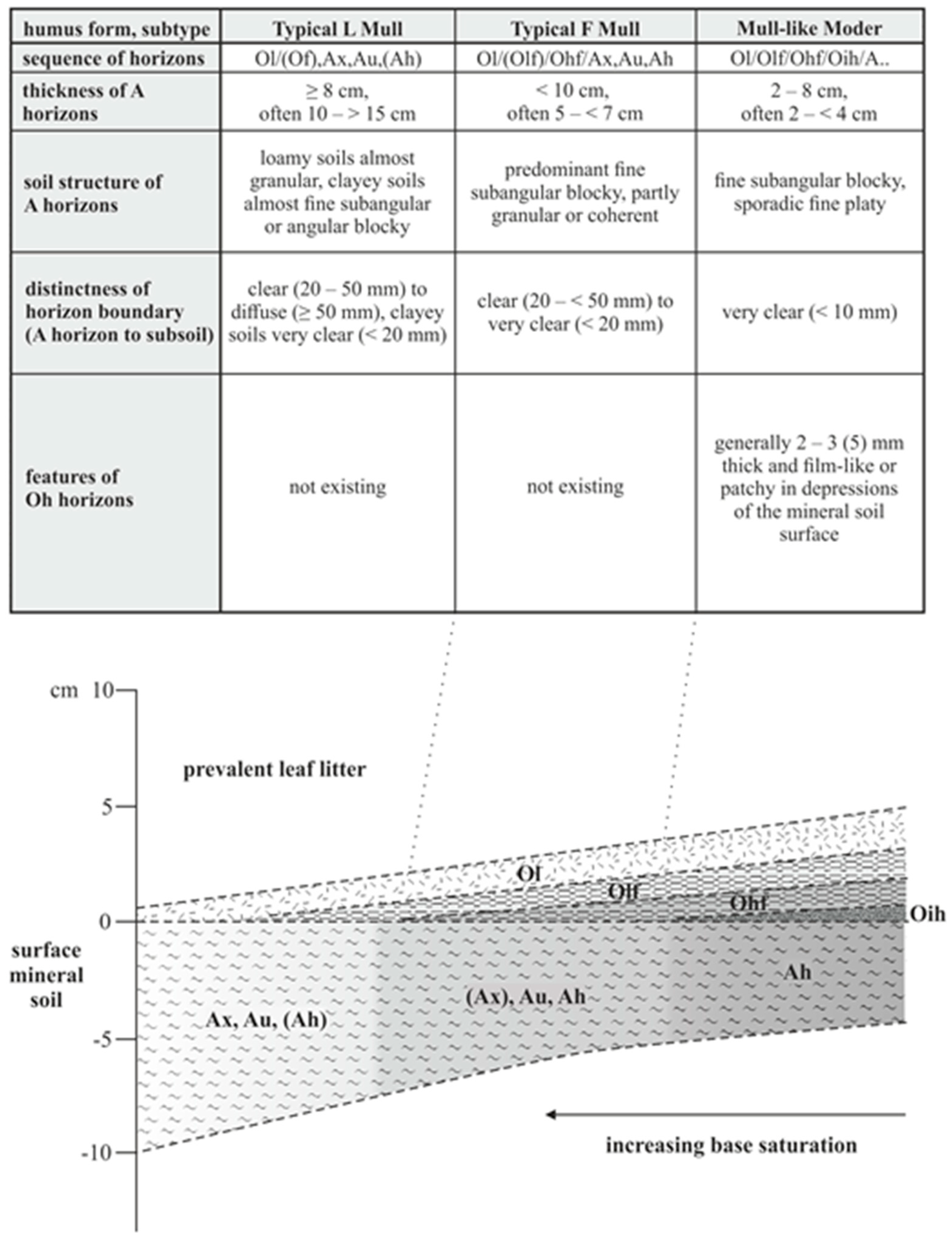
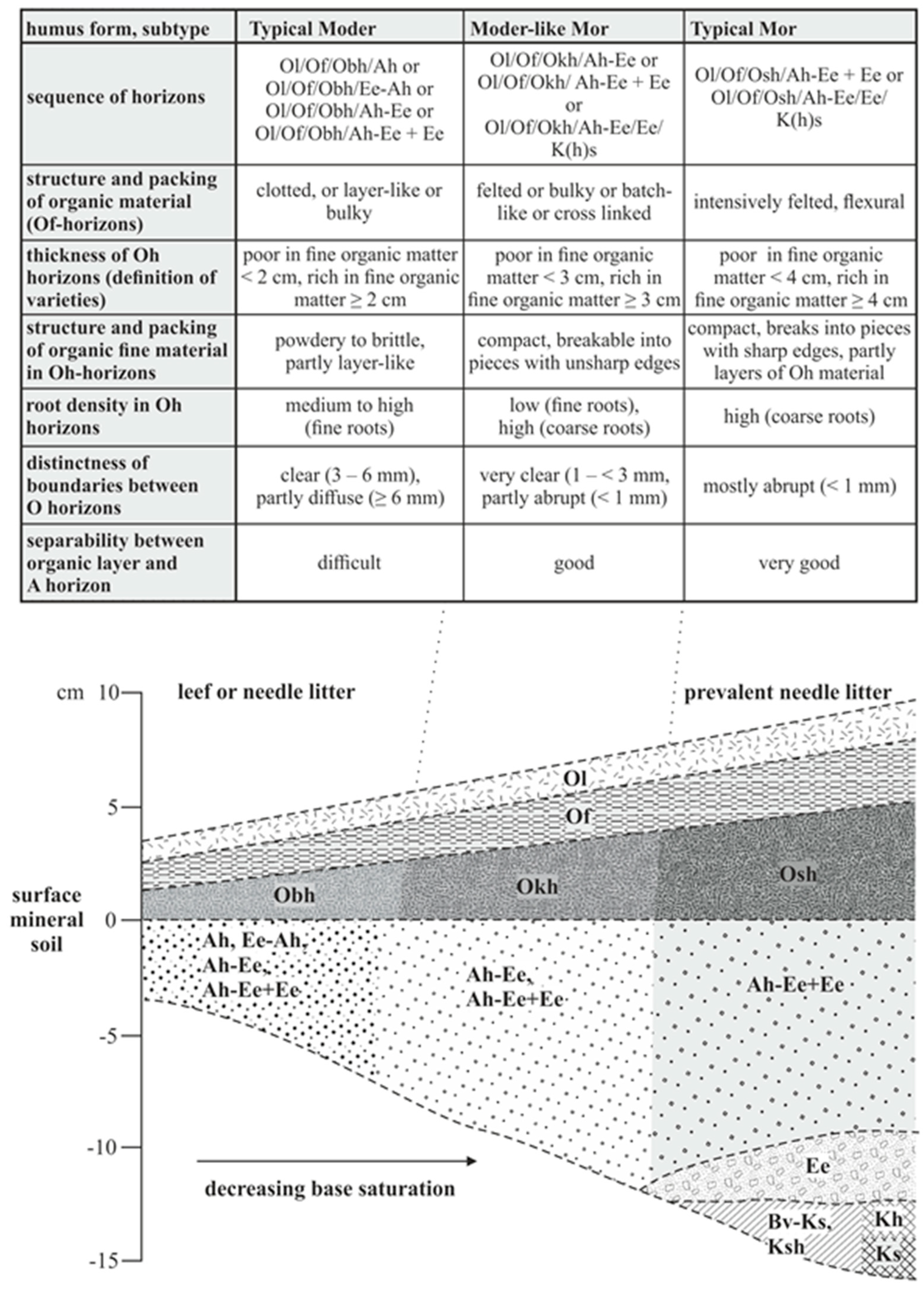
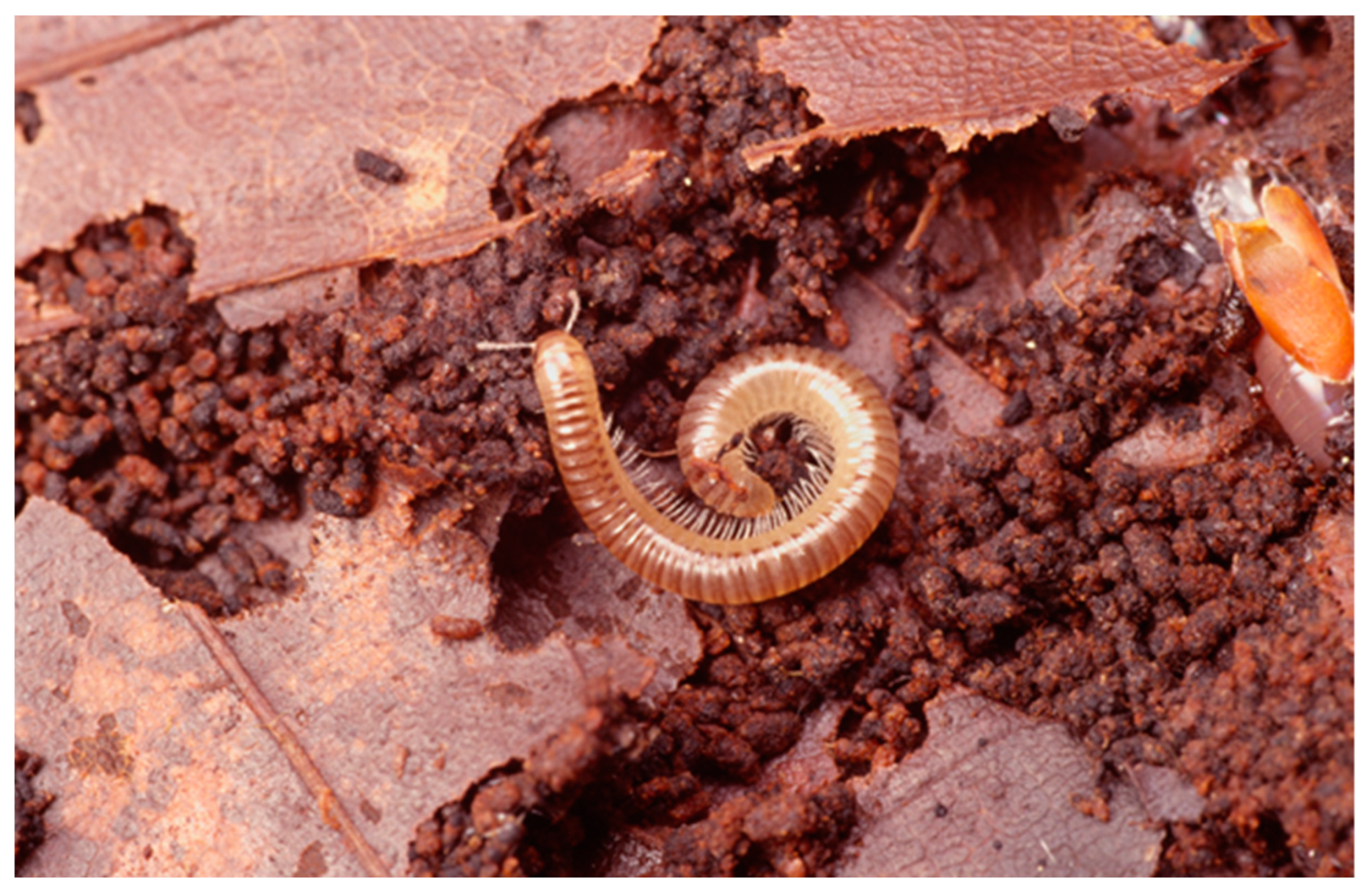
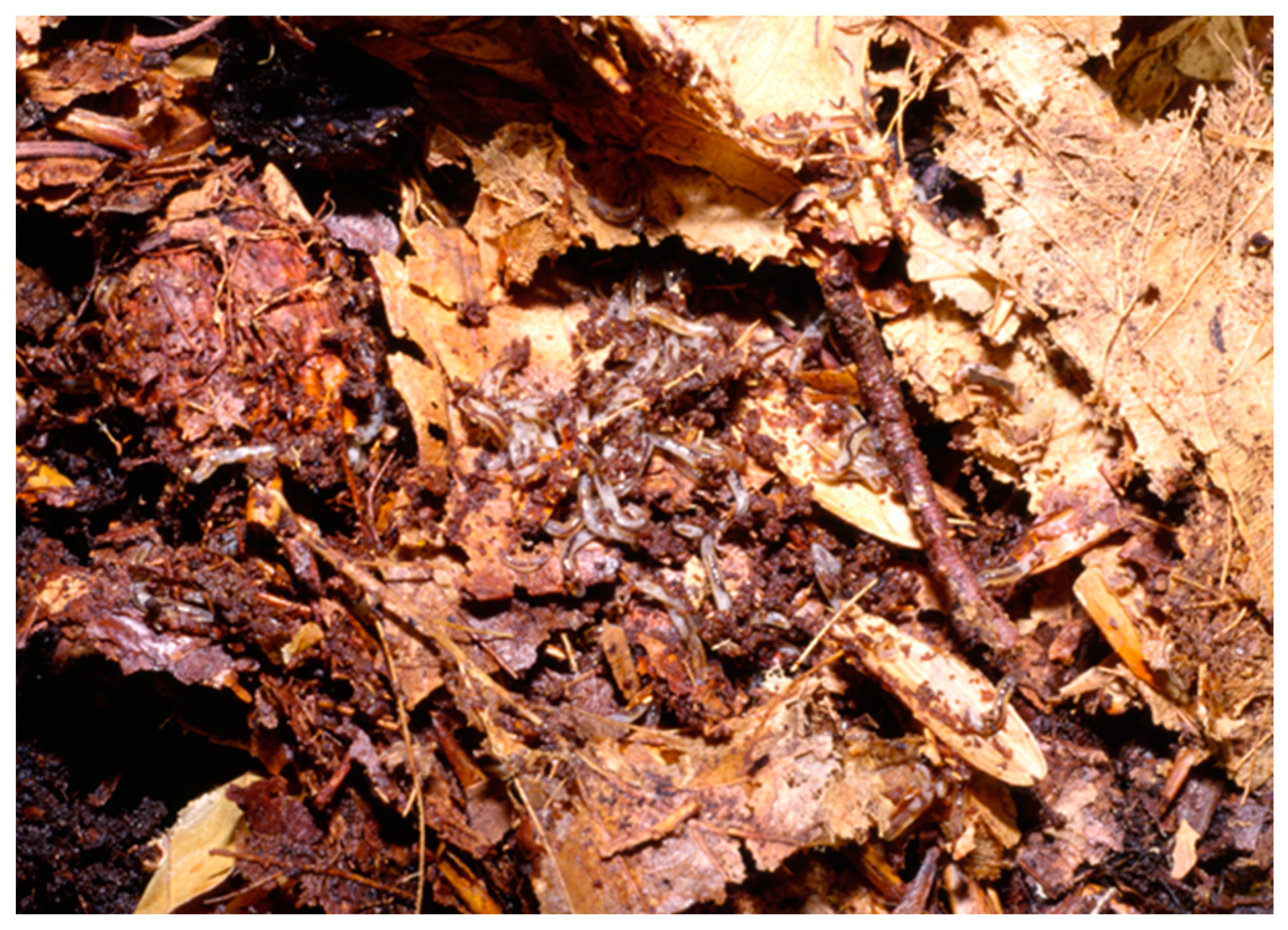

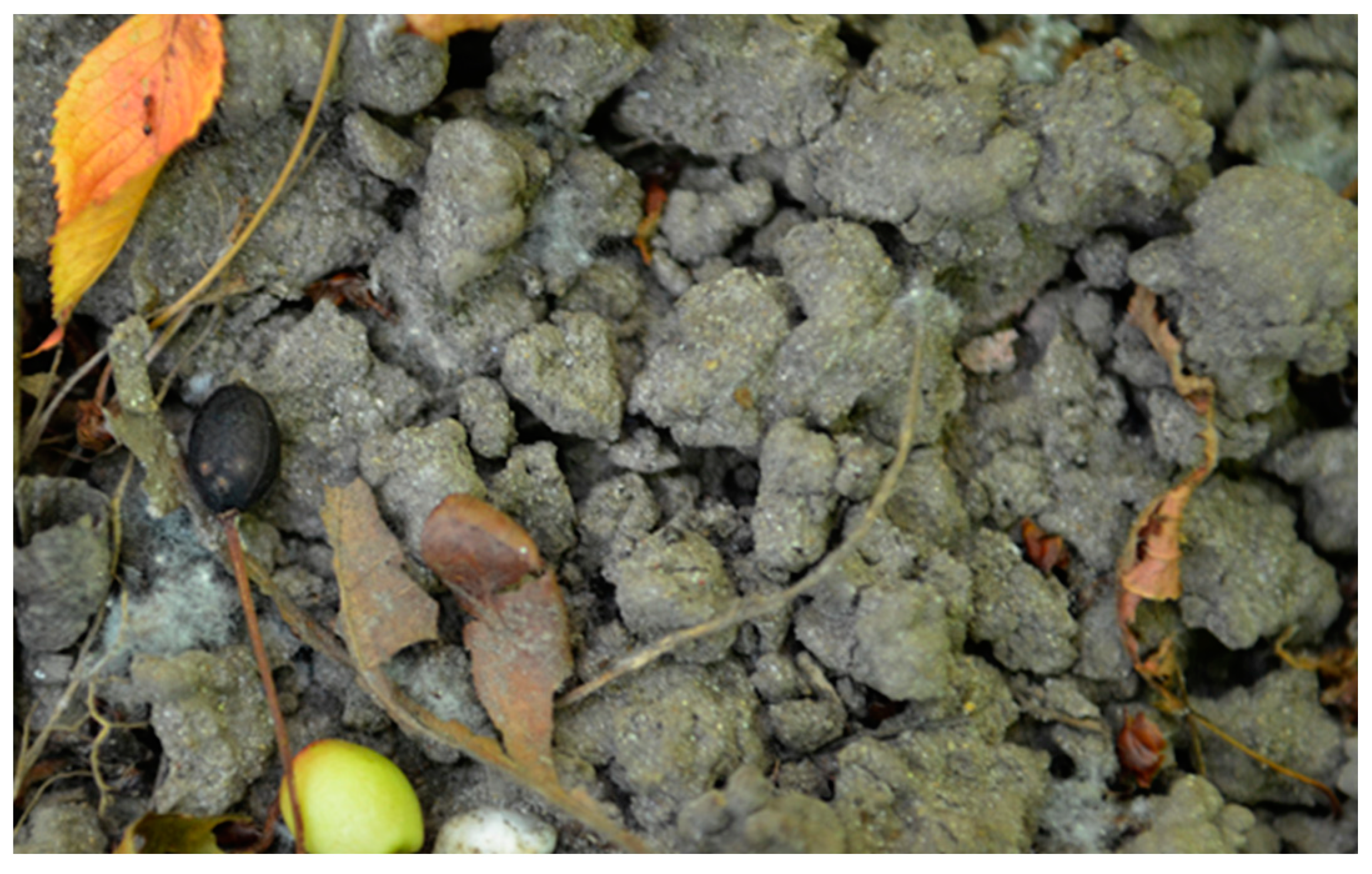
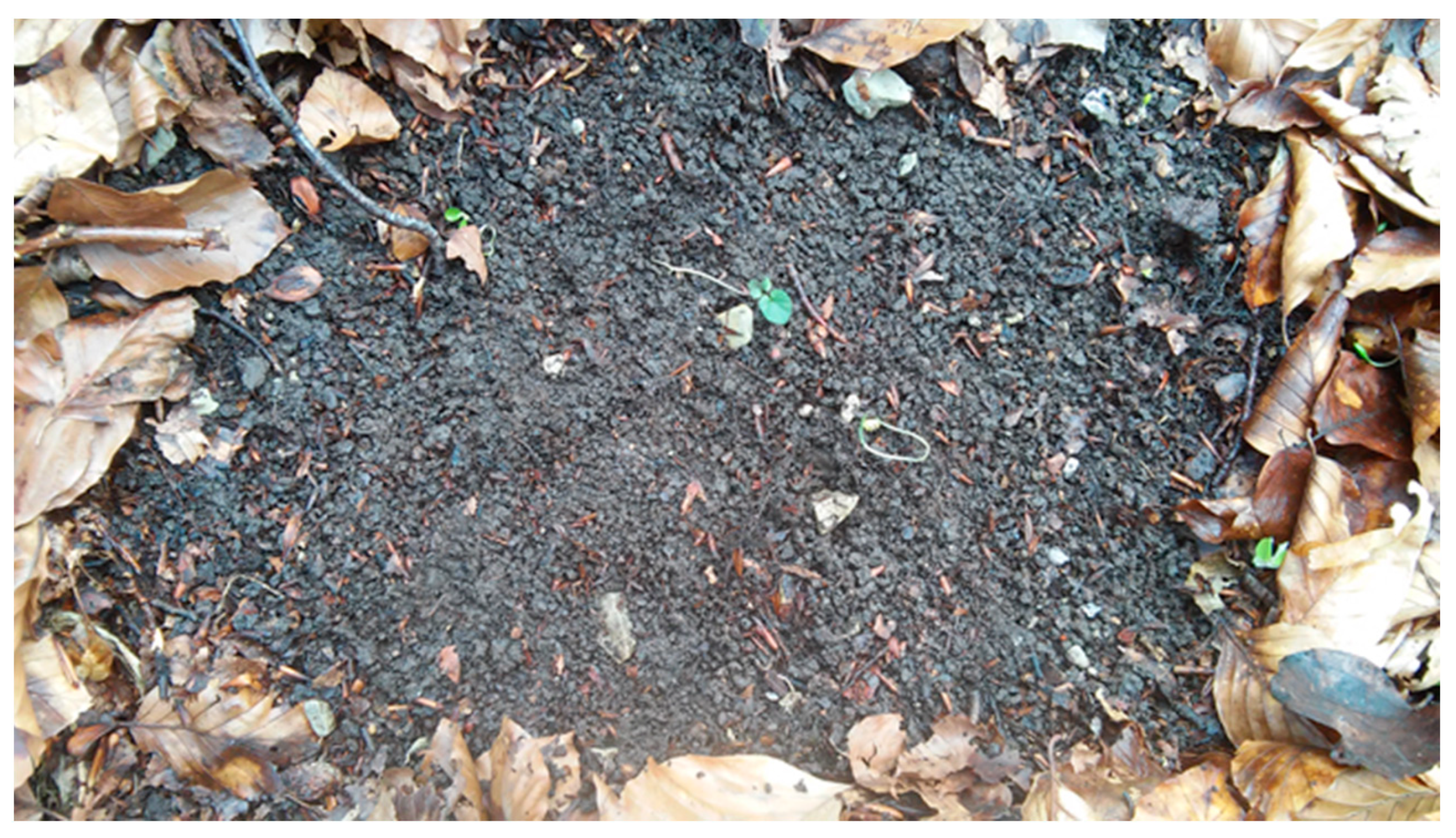
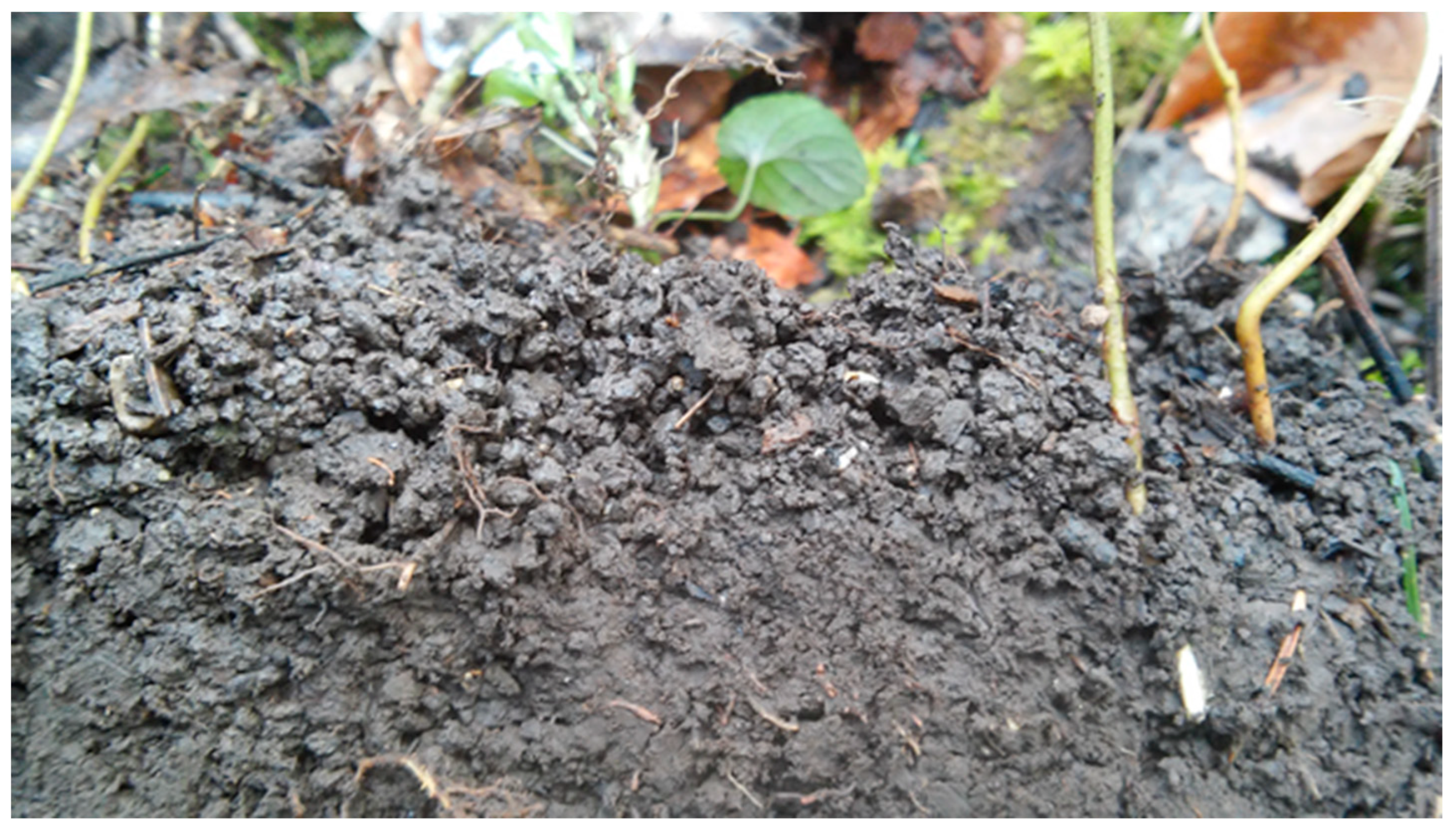


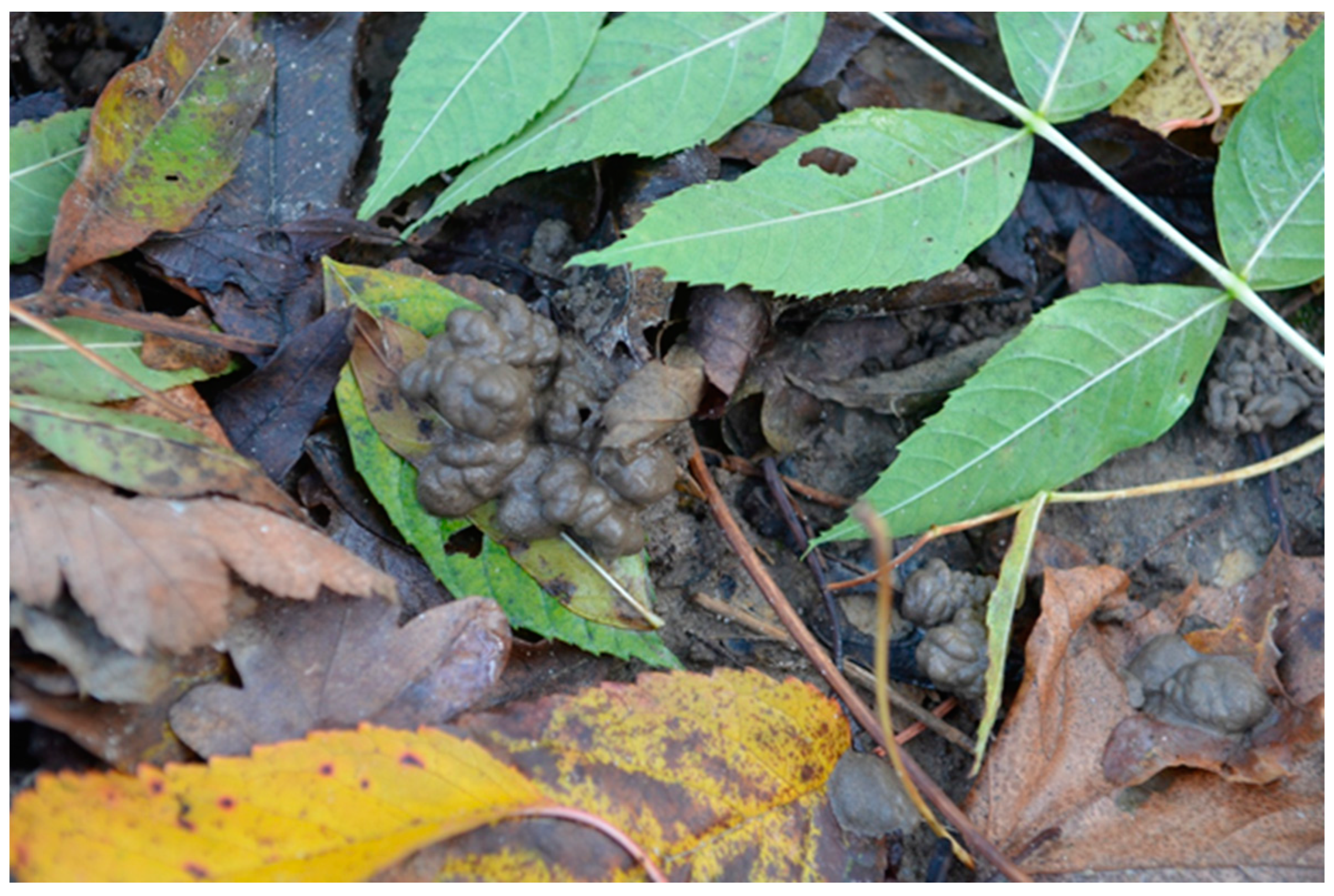
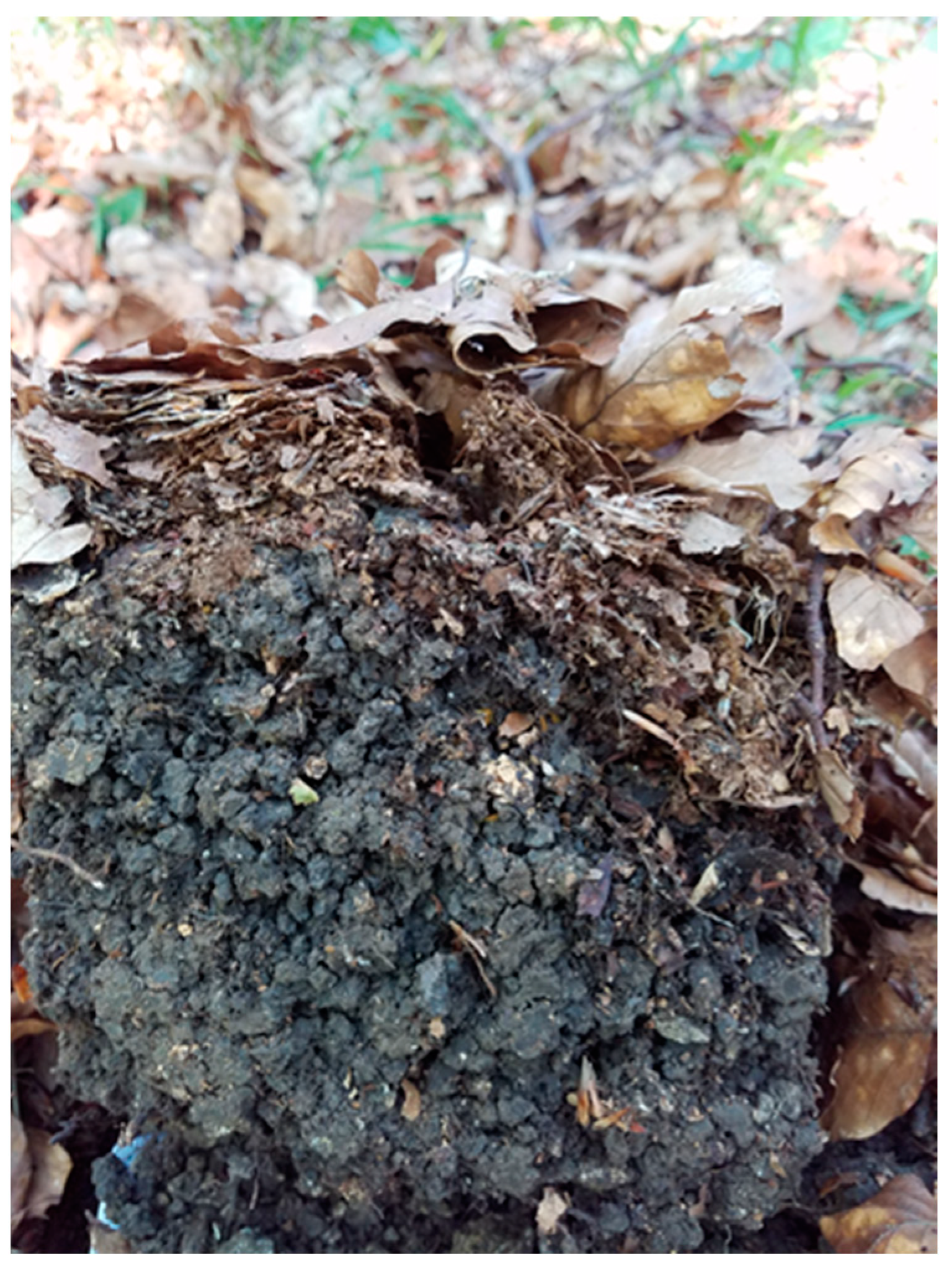
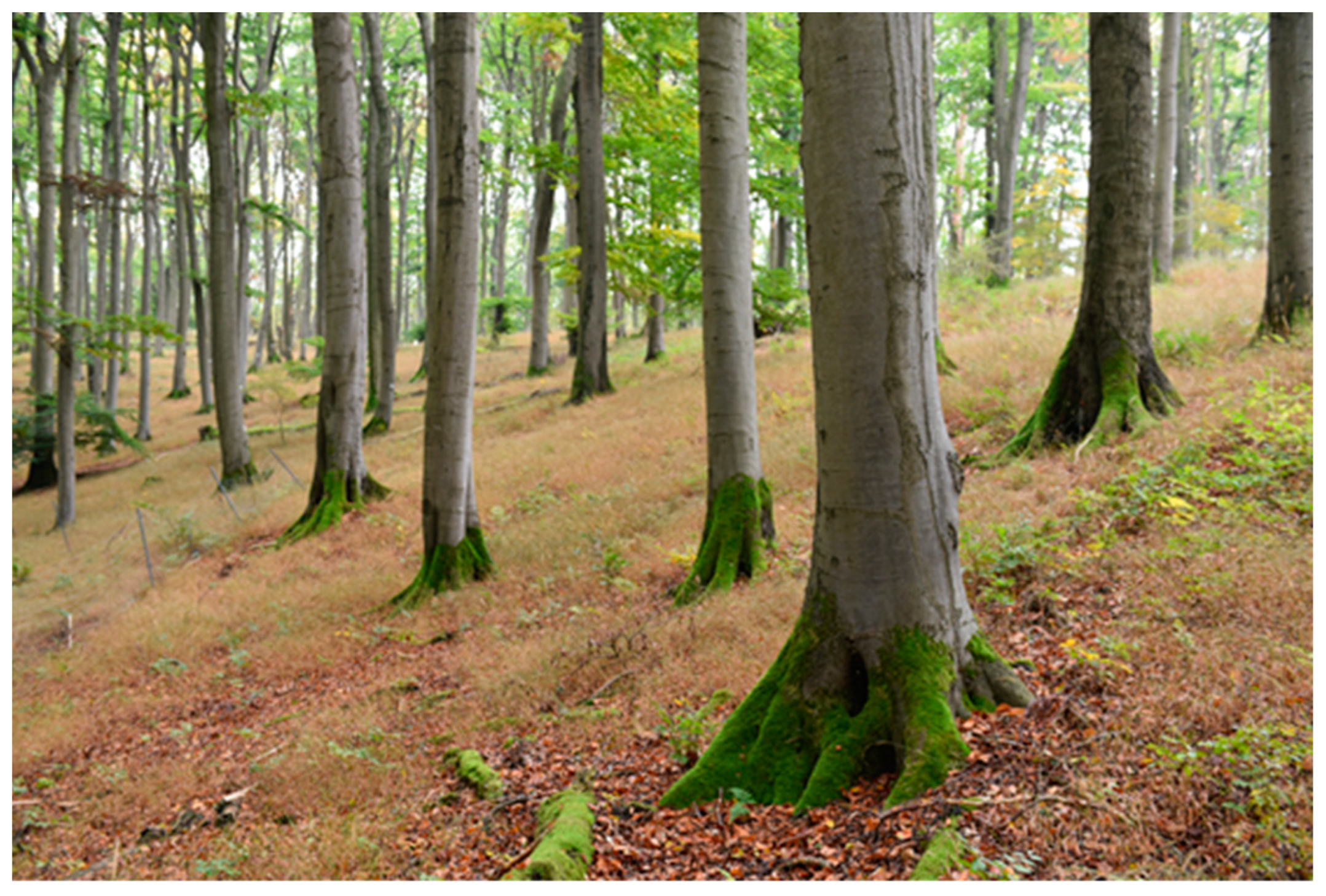
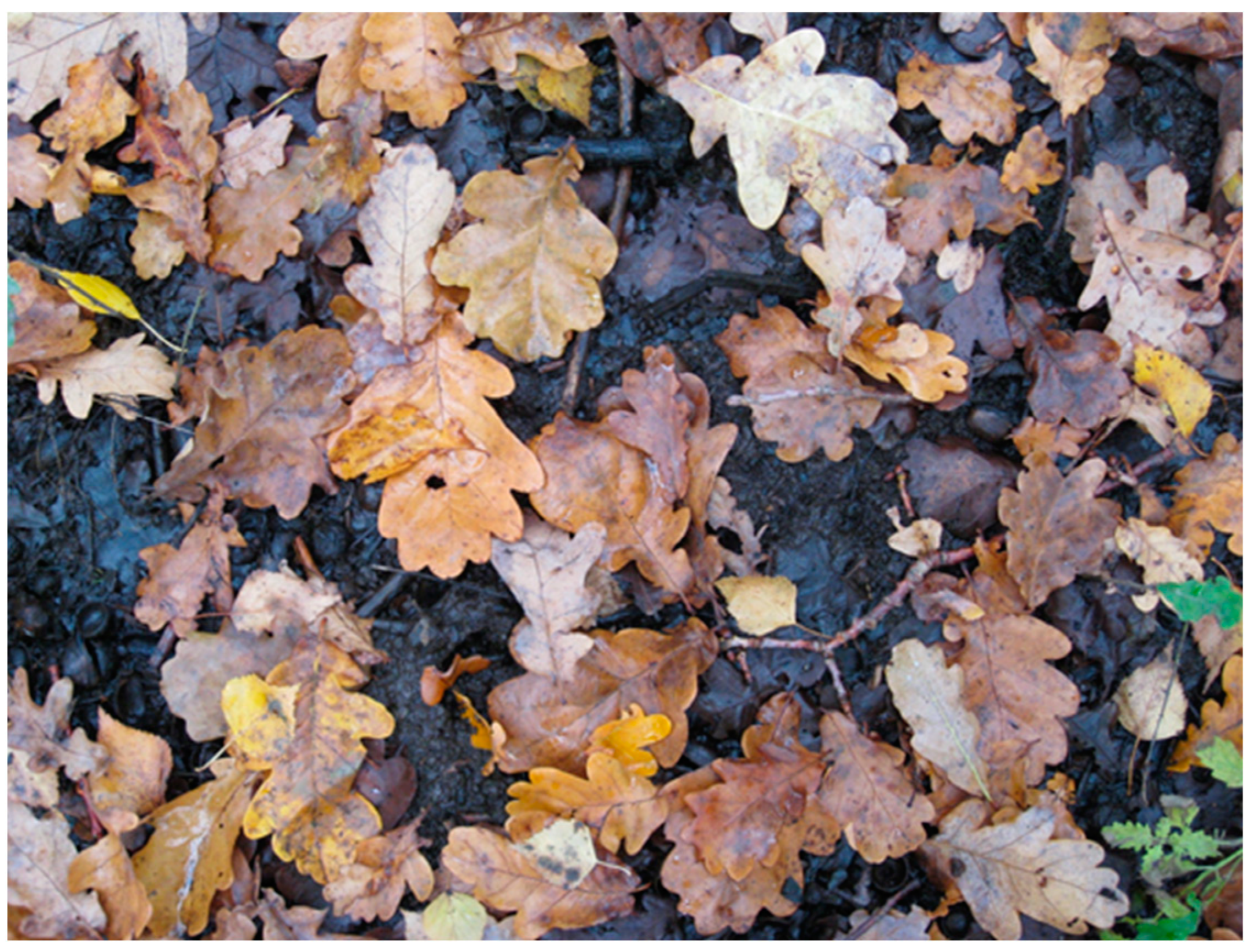
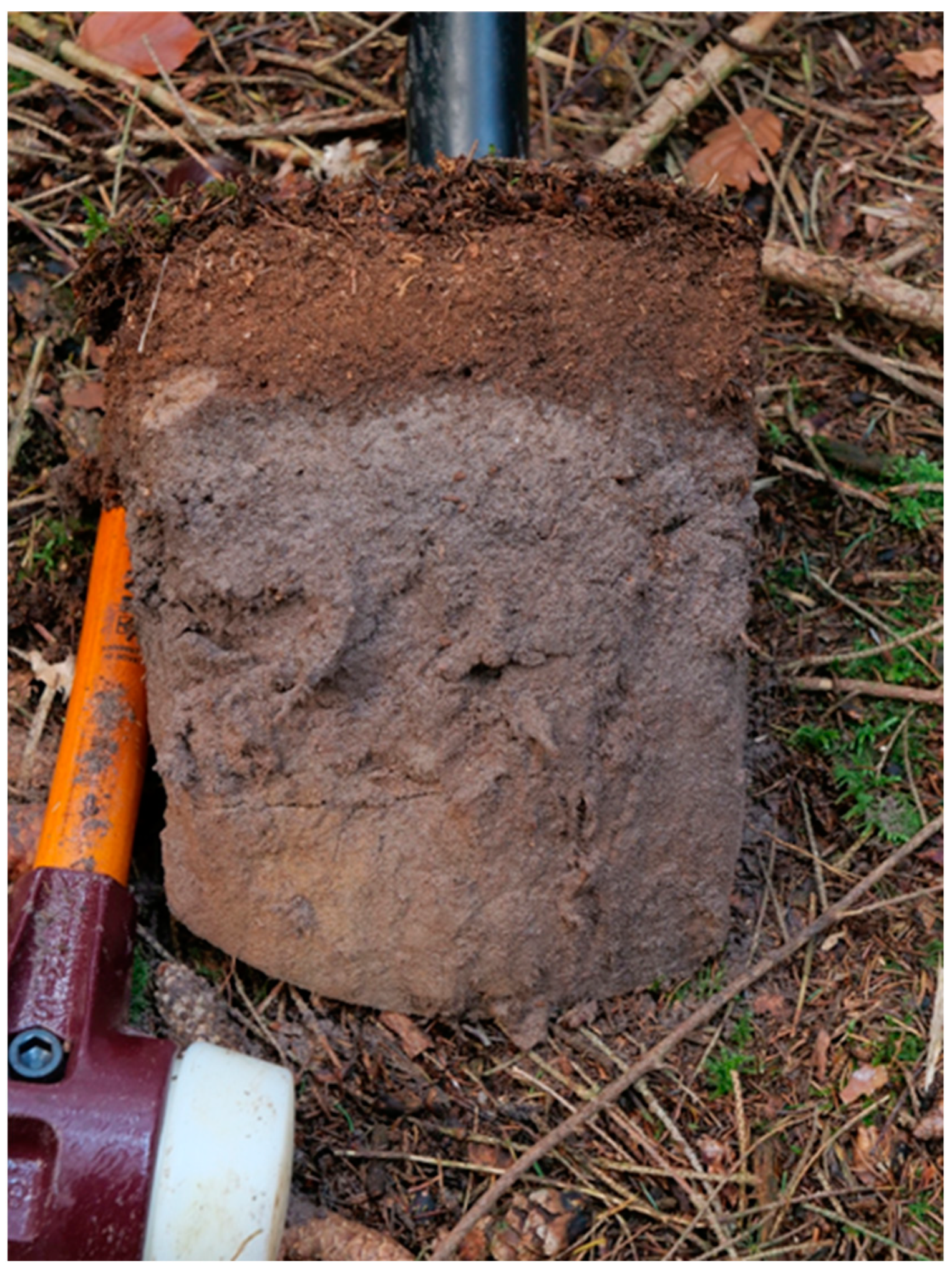


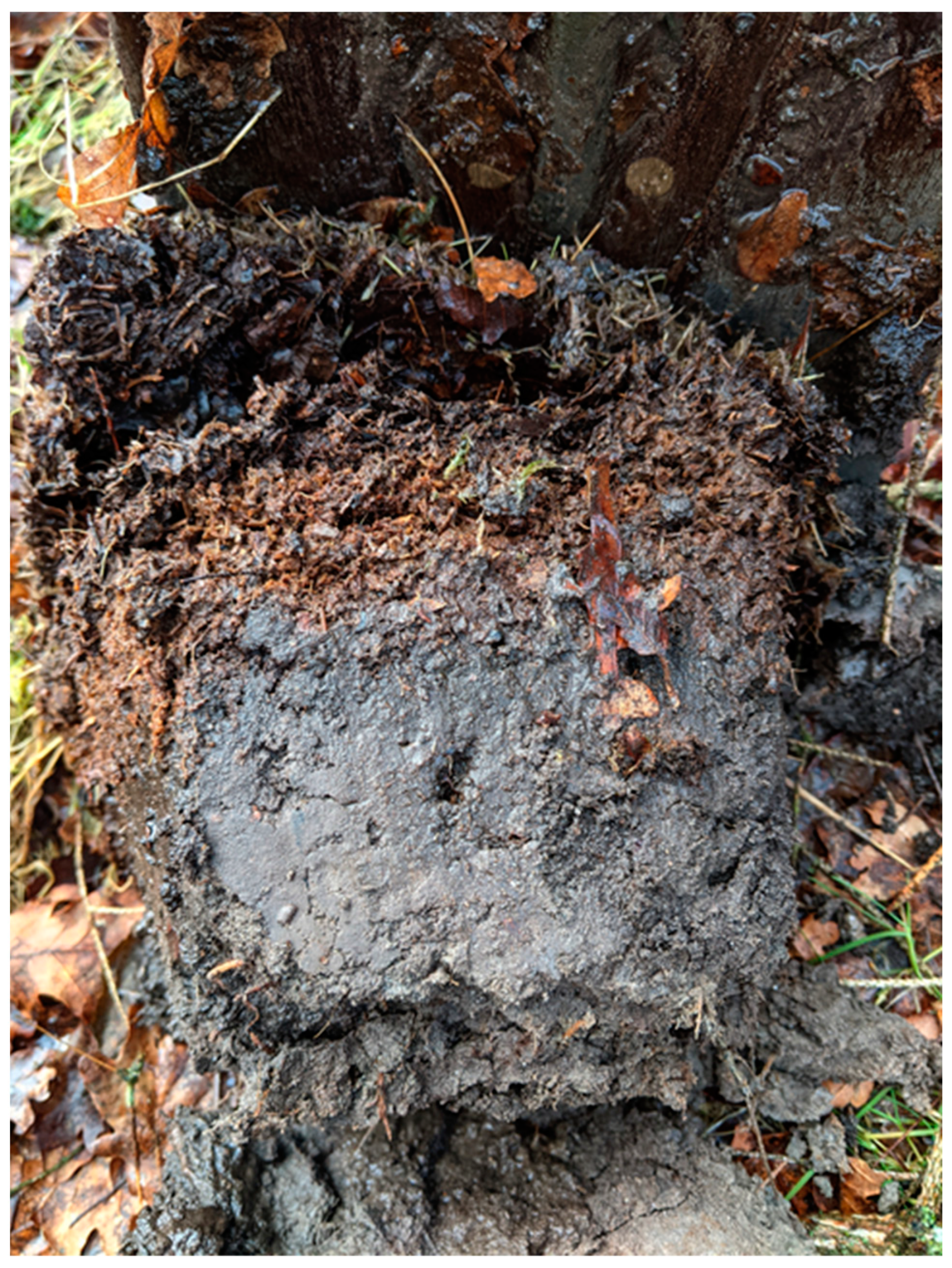
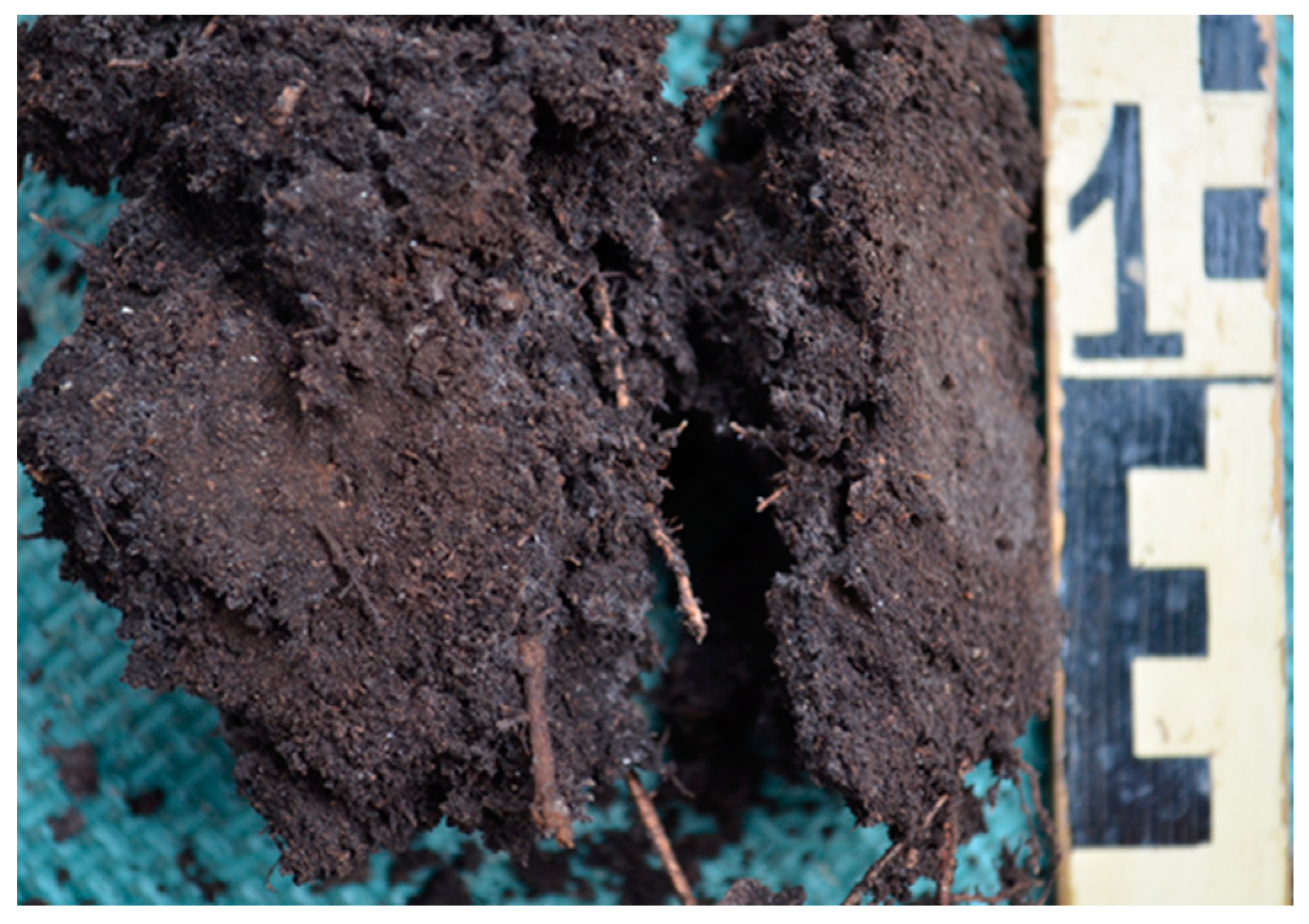

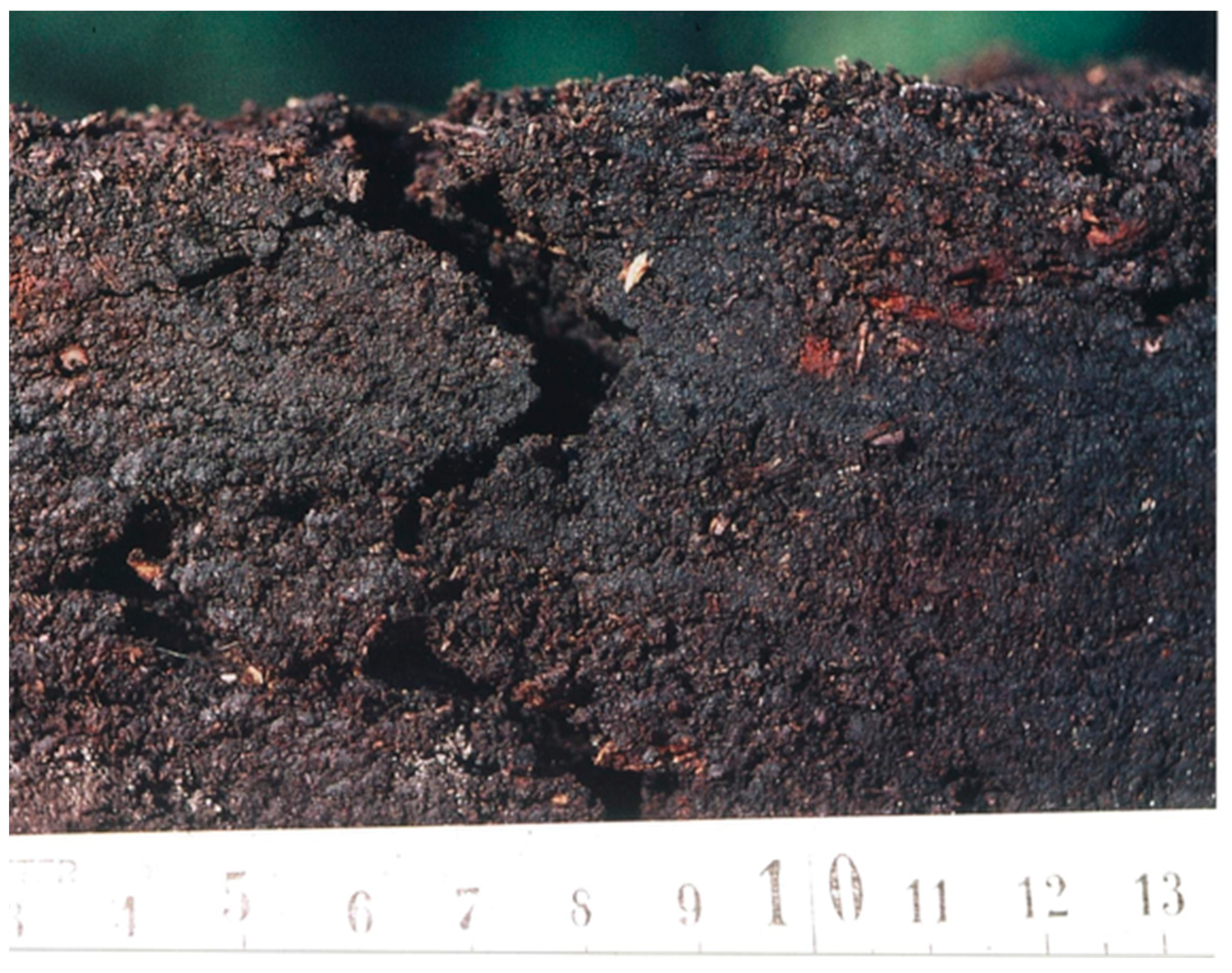
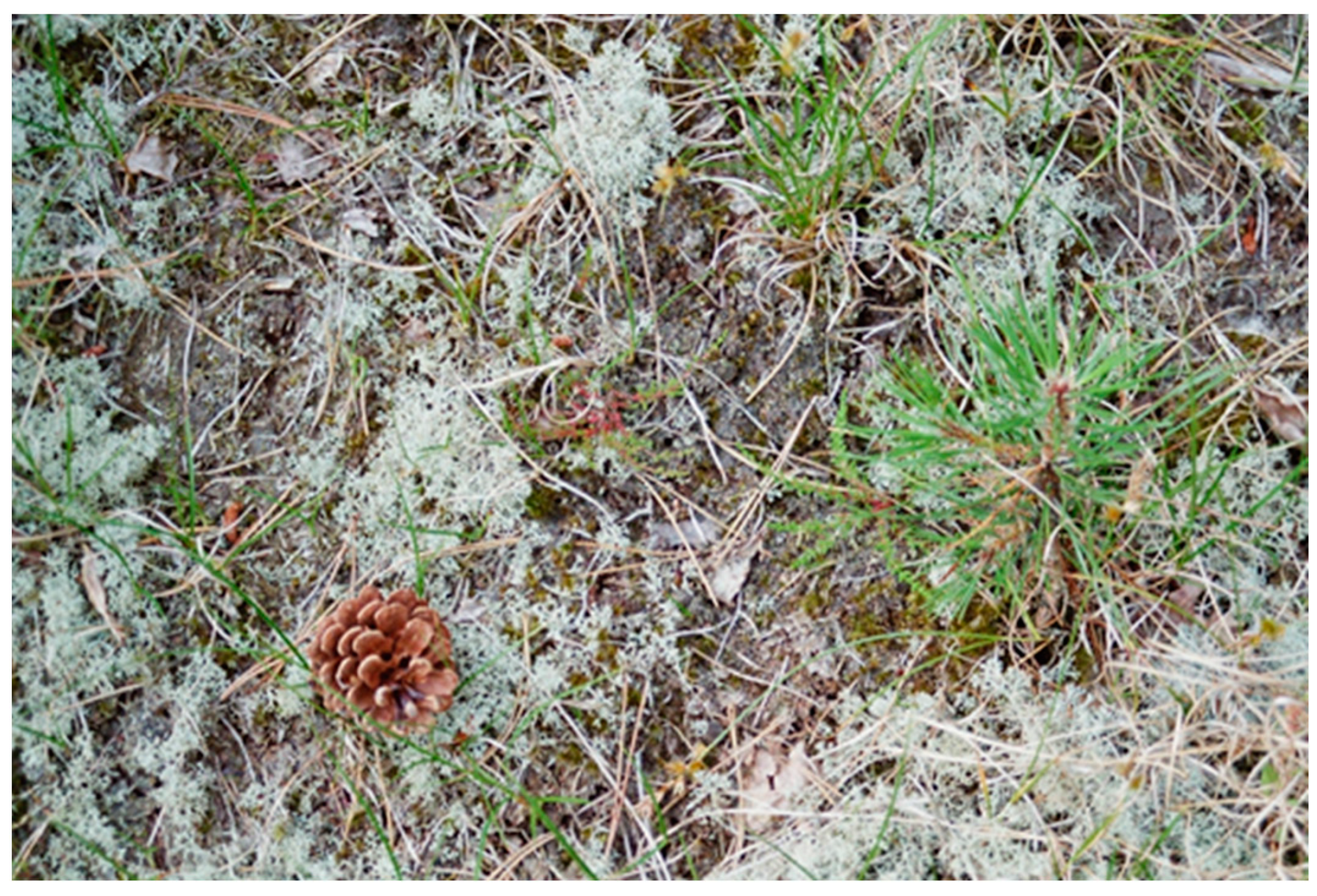
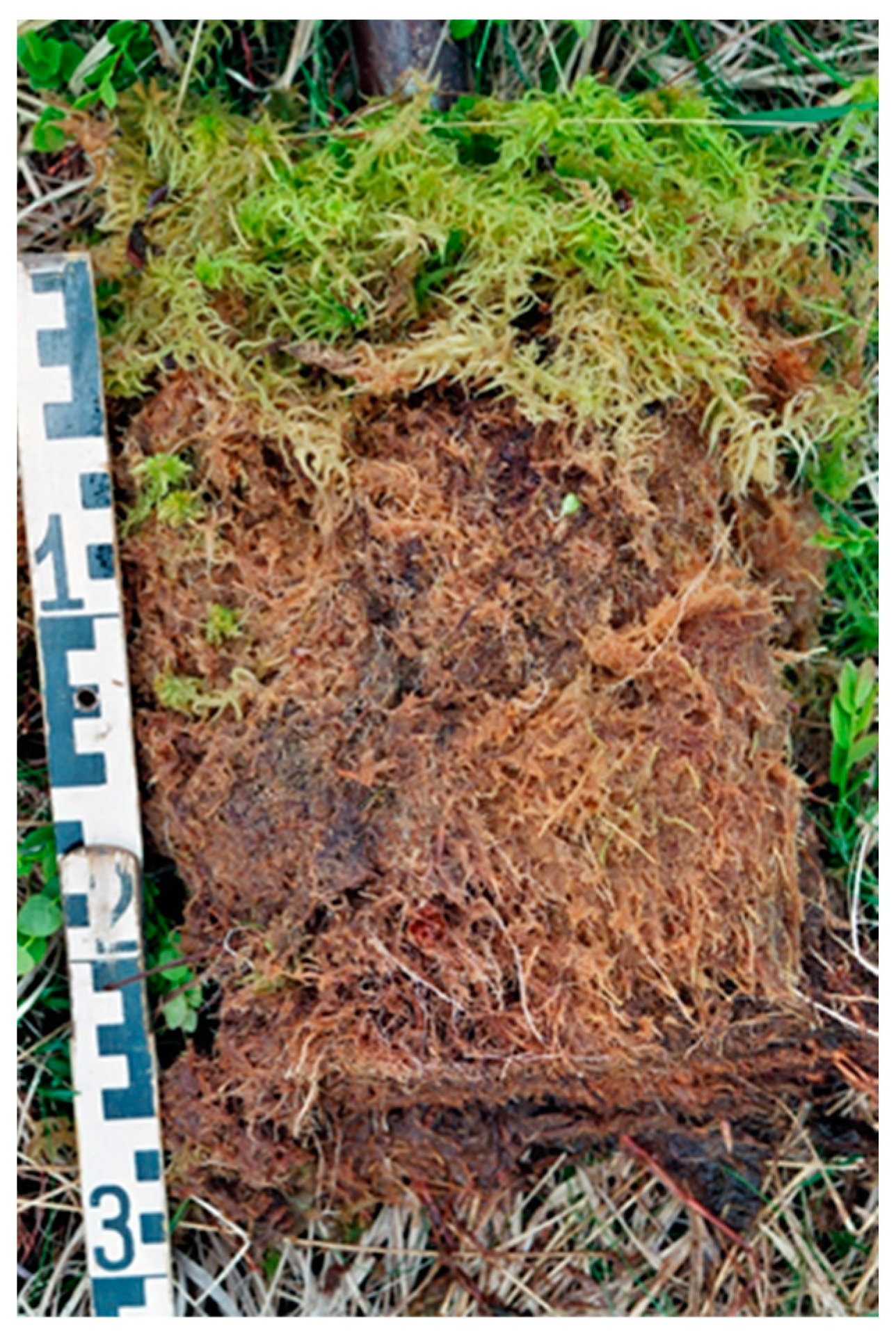
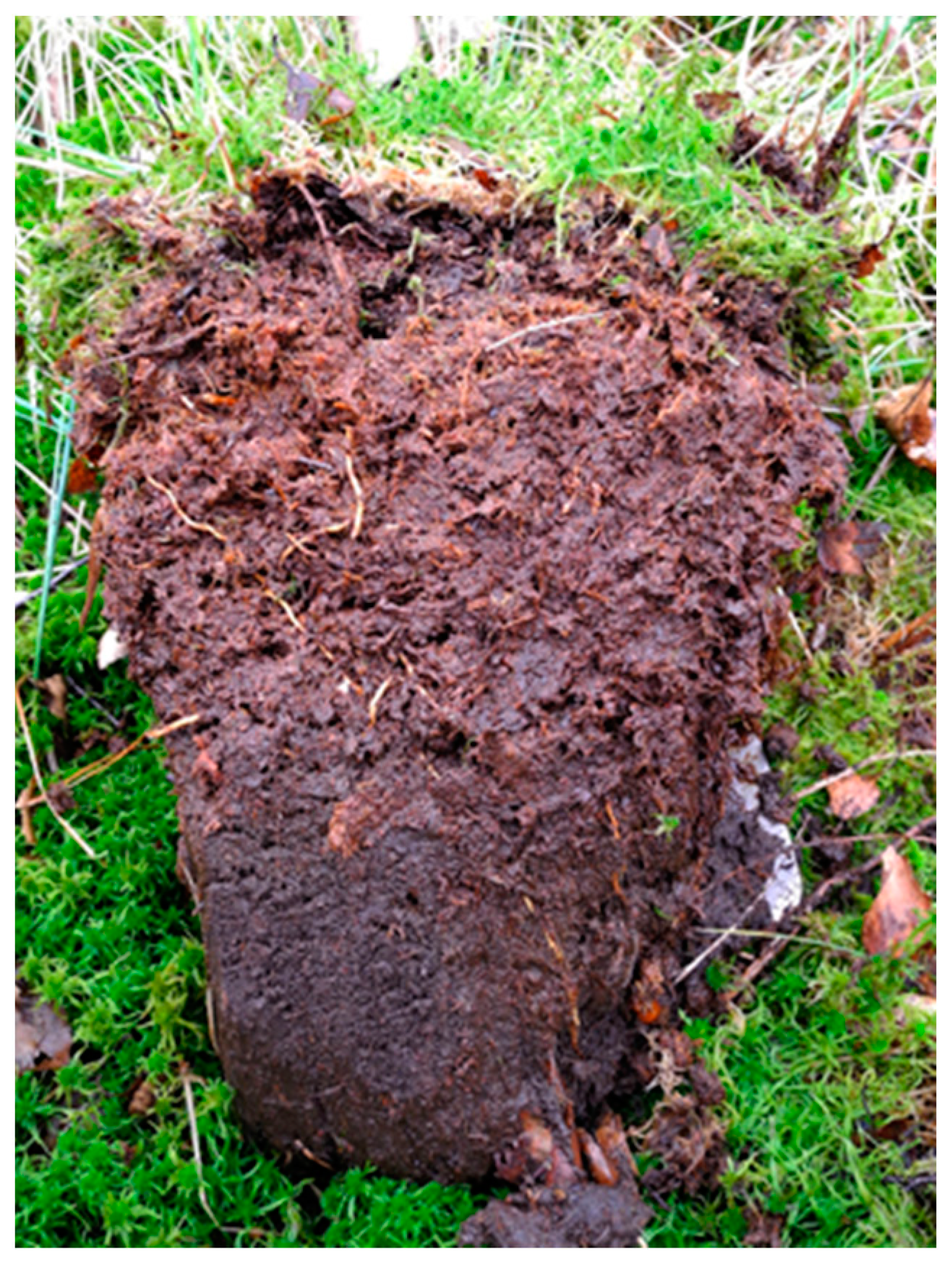
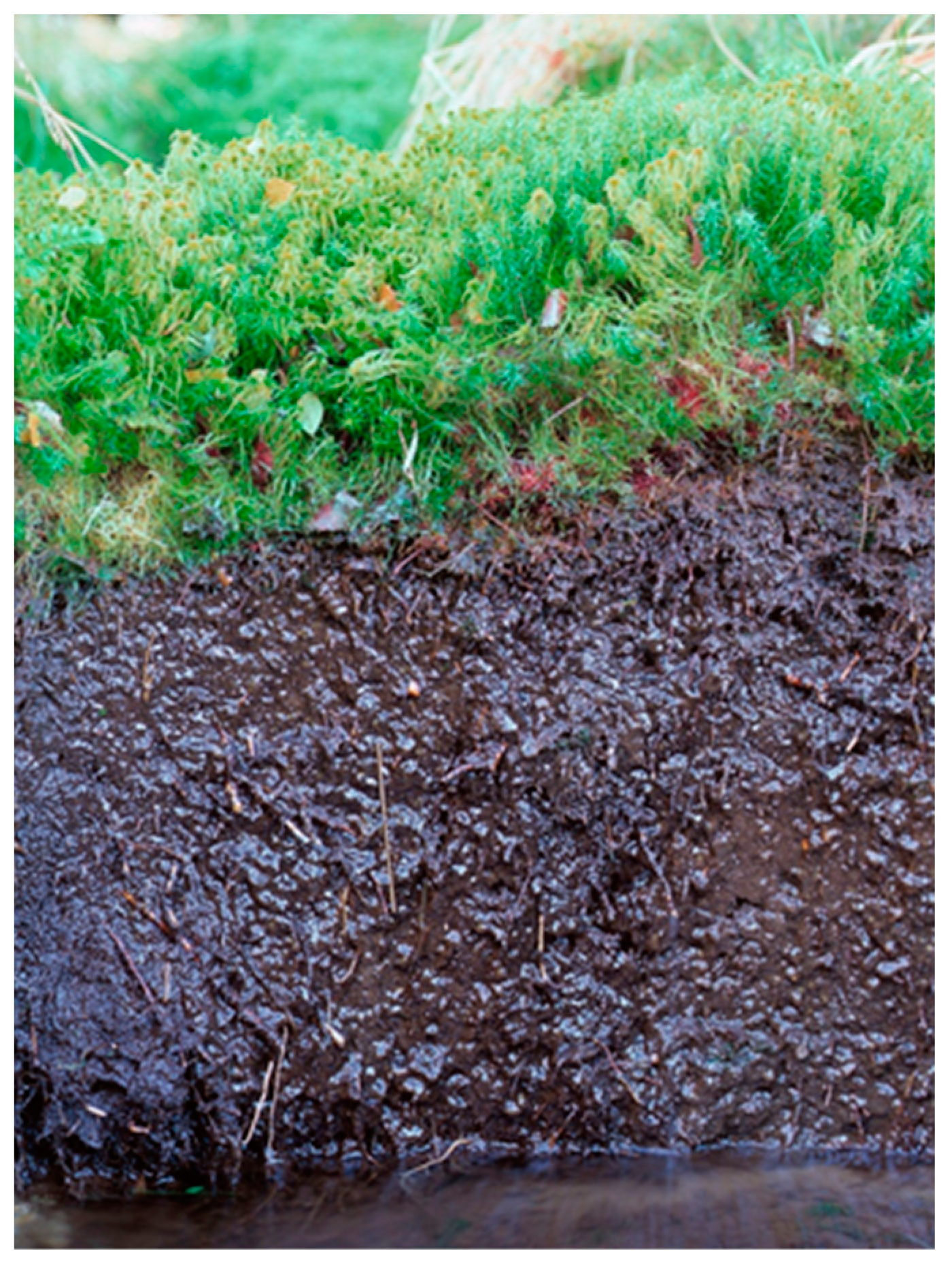
| Term | Description |
|---|---|
| Soil-forming Conditions | |
| aeromorphic | Morphology indicating soil development under well-aerated topsoil conditions |
| aero-hydromorphic | Morphology indicating soil development under moderately aerated or poorly drained topsoil conditions |
| hydromorphic | Morphology indicating soil development under predominantly water saturated topsoil conditions |
| peat formation | Peat formation is the result of incomplete decomposition of the remains of peat-forming plants induced and controlled by conditions such as waterlogging, low oxygen supply, low nutrient availability, or low litter decomposability. |
| peat-forming plants, peat-forming vegetation | Plants which are peat-forming under hydromorphic conditions, for example: sphagnum moss, different carex species, different species of the sedge family |
| cultitropic | Anthropogenic—substantial changes of the nutrients and the base saturation, soil structure due to regular fertilisation and sometimes tillage |
| Humus form | |
| humus form | Order of distinct units defined by organic surface horizons and the first mineral horizon with similar morphology, depths and type of boundary of horizons indicating specific conditions for bioturbation, decomposition, humification, and mineralisation. |
| Horizon | |
| master horizon | Horizon with an important and dominant soil genetic process such as peat forming or podzolisation, for example: O, H, A, S, G, D, R |
| mineral master horizon | Master horizon with a content of organic carbon < 15% mass (A, B, C, G, S) |
| mineral topsoil | Soil layer at the soil surface, with an organic carbon < 15% mass |
| modified horizon | Horizon with a dominant and a subdominant soil genetic process, such as Ohf, an Of horizon with 30–70% volume of organic fine material |
| organic master horizon | Master horizon with a content of organic carbon ≥ 15% mass (O, H, U) |
| organic surface layer | Sum of all macroscopically visible distinct organic material characterised by texture and packing of the organic material overlying the mineral soil. Layers may vary in percentages of macroscopically visible plant residues and organic fine material |
| organic surface horizon | Organic horizon at the surface of soils (O, H or U horizon) |
| soil horizon | Soil area which summarises common features as a result of soil forming processes |
| topsoil | All soil layers (organic surface layer and top mineral soil) comprising the humus form. At forest sites, the term forest floor is often synonymously used |
| transition horizon | Soil horizon with two or three important soil genetic processes, for example Ah-Go (humus accumulation and groundwater influence, typical of transition soil types) |
| Processes and properties of organic matter | |
| degree of decomposition and humification | Deduced by the percentage of macroscopically recognisable plant residues and organic fine material in the peat. Ranging from H1 (plant structures completely visible) to H10 (100% organic fine material) |
| humus | All organic matter on the soil surface and within the soil, comprising dead plant, microbial, or faunal residues and their transformation products |
| humification | Processes of decomposition and humification of plant material via hydrolysis or oxidation and reduction mediated by soil organisms, resulting in a continuum of organic material (plant, microbial, and faunal metabolites) of various molecular sizes and composition. |
| organic fine material | Dark-coloured, amorphous organic matter, without macroscopically recognisable tissue structures occurring in the organic surface layer, peat or mineral soil |
| packaging and structure of O material | Describes how units of the O layers are interconnected |
| peat | Accumulation of plant material under anaerobic conditions. Plant material varies in the degree of decomposition and humification |
| Division | Class | Type | Subtype | Code |
|---|---|---|---|---|
| Aeromorphic and Aero-Hydromorphic humus forms | ||||
| Mull humus forms | M | |||
| L Mull | ML | |||
| A Mull | MLA | |||
| Typical L Mull | MLT | |||
| Rhizo L Mull | MLR | |||
| Moist L Mull | MLF | |||
| F Mull | MF | |||
| L Mull-like F Mull | MFL | |||
| Typical F Mull | MFT | |||
| Rhizo F Mull | MFR | |||
| Moder-like F Mull | MFM | |||
| Moist F Mull | MFF | |||
| Humus forms with an Oh horizon | A | |||
| Moder | AM | |||
| Mull-like Moder | AMM | |||
| Typical Moder | AMT | |||
| Rhizo Moder | AMR | |||
| Pechmoder | AMP | |||
| Tangel | AMA | |||
| Moist Moder | AMF | |||
| Mor | AR | |||
| Moder-like Mor | ARM | |||
| Typical Mor | ART | |||
| Moist Mor | ARF | |||
| Initial humus forms | I | |||
| Initial Mull | IM | |||
| Initial humus form with organic surface layers | IA | |||
| Naturally and Anthropogenically deteriorated humus forms | X | |||
| Naturally deteriorated humus form | XH | |||
| Anthropogenically deteriorated humus form | XR | |||
| Hydromorphic humus forms | ||||
| Anmoor | O | |||
| Anmoor | OA | |||
| Humus forms of natural fen and bog | ||||
| F Moor | HF | |||
| Mesotrophic F Moor | HFM | |||
| Oligotrophic F Moor | HFO | |||
| Dystrophic F Moor | HFD | |||
| M Moor | HM | |||
| Eutrophic M Moor | HME | |||
| Mesotrophic M Moor | HMM | |||
| Oligotrophic M Moor | HMO | |||
| H Moor | HH | |||
| Polytrophic H Moor | HHP | |||
| Eutrophic H Moor | HHE | |||
| Mesotrophic H Moor | HHM | |||
| Oligotrophic H Moor | HHO | |||
| Humus Form Type (Degree of Decomposition and Humification) | Diagnostic horizon (Degree of Peat Decomposition and Humification) | Humus Form Subtype (Range of CN Ratio of the Peat at the Soil Surface) |
|---|---|---|
| F Moor (fibric) | Hfn (H1–H4) | Mesotrophic F Moor (≥20–33) |
| Oligotrophic F Moor (≥33–40) | ||
| Dystrophic F Moor ((≥40)) | ||
| M Moor (hemic) | Hen (H5–H6) | Eutrophic M Moor (≥10–20) |
| Mesotrophic M Moor (≥20–33) | ||
| Oligotrophic M Moor (≥33–40) | ||
| H Moor (humic) | Hhn (H7–H10) | Polytrophic H Moor (<10) |
| Eutrophic H Moor (≥10–20) | ||
| Mesotrophic H Moor (≥20–33) | ||
| Oligotrophic H Moor (≥33–40) |
Disclaimer/Publisher’s Note: The statements, opinions and data contained in all publications are solely those of the individual author(s) and contributor(s) and not of MDPI and/or the editor(s). MDPI and/or the editor(s) disclaim responsibility for any injury to people or property resulting from any ideas, methods, instructions or products referred to in the content. |
© 2023 by the authors. Licensee MDPI, Basel, Switzerland. This article is an open access article distributed under the terms and conditions of the Creative Commons Attribution (CC BY) license (https://creativecommons.org/licenses/by/4.0/).
Share and Cite
Wachendorf, C.; Frank, T.; Broll, G.; Beylich, A.; Milbert, G. A Concept for a Consolidated Humus Form Description—An Updated Version of German Humus Form Systematics. Int. J. Plant Biol. 2023, 14, 658-686. https://doi.org/10.3390/ijpb14030050
Wachendorf C, Frank T, Broll G, Beylich A, Milbert G. A Concept for a Consolidated Humus Form Description—An Updated Version of German Humus Form Systematics. International Journal of Plant Biology. 2023; 14(3):658-686. https://doi.org/10.3390/ijpb14030050
Chicago/Turabian StyleWachendorf, Christine, Tina Frank, Gabriele Broll, Anneke Beylich, and Gerhard Milbert. 2023. "A Concept for a Consolidated Humus Form Description—An Updated Version of German Humus Form Systematics" International Journal of Plant Biology 14, no. 3: 658-686. https://doi.org/10.3390/ijpb14030050
APA StyleWachendorf, C., Frank, T., Broll, G., Beylich, A., & Milbert, G. (2023). A Concept for a Consolidated Humus Form Description—An Updated Version of German Humus Form Systematics. International Journal of Plant Biology, 14(3), 658-686. https://doi.org/10.3390/ijpb14030050






